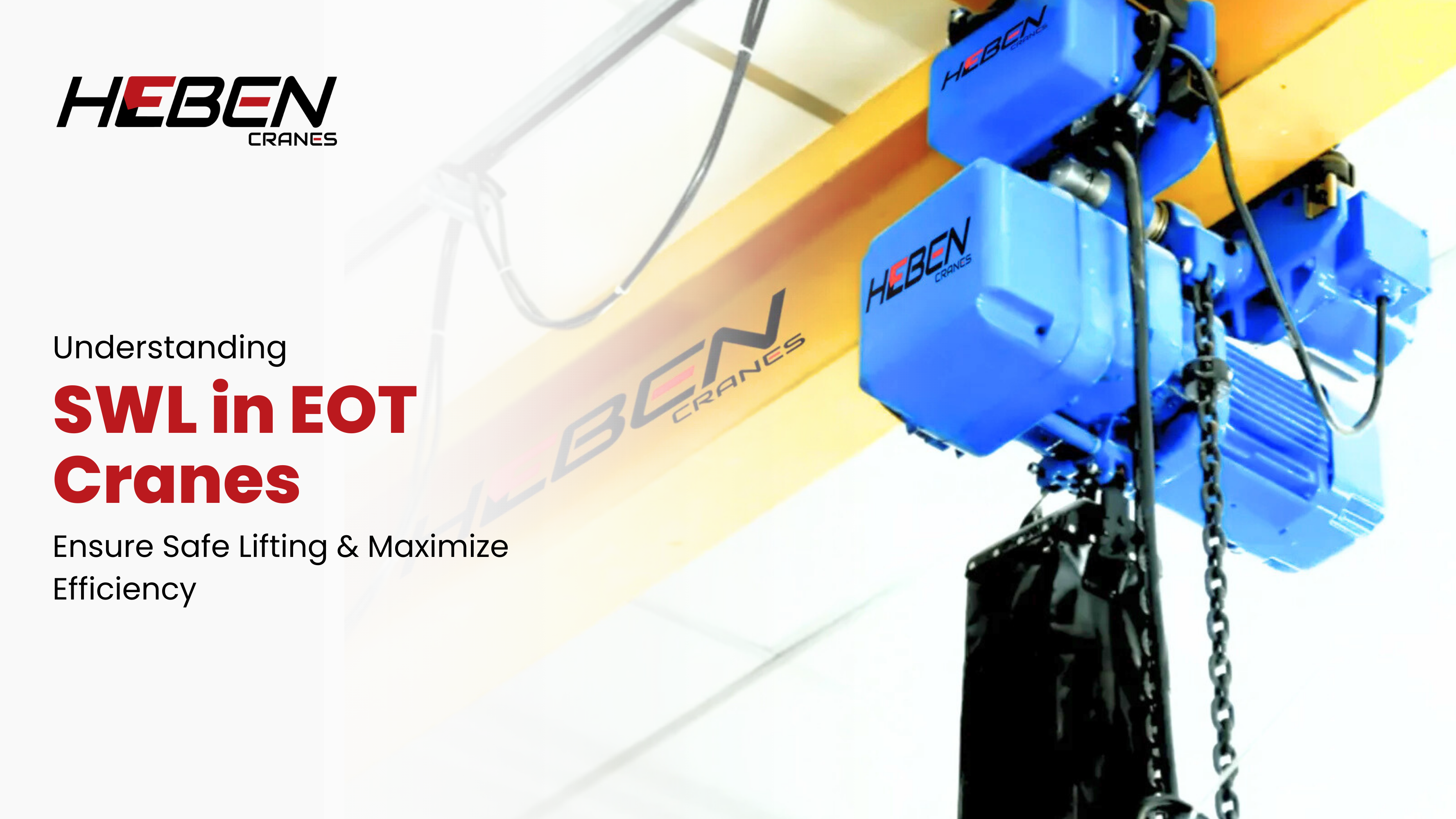Imagine this: A manufacturing plant avoids $2.4 million in potential downtime costs annually by strictly adhering to Safe Working Load (SWL) limits on their EOT cranes. This isn’t theoretical. It’s the power of understanding SWL, the unsung hero of industrial safety and efficiency. Let’s dive into why this single metric separates thriving operations from catastrophic failures.
Understanding EOT Cranes: The Backbone of Modern Industry
Electric Overhead Traveling (EOT) cranes are the workhorses of heavy industry, with 78% of large-scale manufacturing facilities relying on them for critical lifting operations. These systems combine precision engineering with raw power, featuring:
- Parallel runways acting as elevated railroads for the crane bridge
- Electric hoists capable of lifting payloads equivalent to 20 adult elephants (up to 100 tonnes)
- Temperature resilience from -20°C to 40°C, making them versatile but not indestructible
Heben Cranes revolutionized this space by introducing AI-driven predictive maintenance in their EOT systems, reducing unexpected breakdowns by 63% compared to conventional models. Their double girder cranes now feature real-time load monitoring sensors that feed data to plant-wide IoT networks, creating what industry experts call “the nervous system of smart factories.”
Defining SWL: The Lifeline of Crane Operations
Safe Working Load (SWL) isn’t just a number—it’s a complex calculation factoring in:
SWL = Minimum Breaking Load / Safety Factor
Where safety factors typically range from 3:1 to 5:1 for critical lifts.
For example, Heben’s 20-ton SWL crane can theoretically withstand 60–100 tons before failure. But crossing SWL triggers their proprietary LoadGuard™ system that:
- Activates automatic braking
- Sends emergency alerts to supervisors’ devices
- Logs incident details in blockchain-secured records
“SWL is the heartbeat of crane safety,” explains Dr. Anika Rao, lead engineer at Heben.
“Our cranes don’t just stop at 110% overload—they predict strain patterns to prevent dangerous lifts before they happen.”
The Critical Importance of SWL: Beyond Compliance
A 2024 study of 1,200 industrial accidents revealed:
- 87% of crane-related injuries involved SWL violations
- Facilities using SWL monitoring systems saw 41% fewer OSHA violations
- Every 1% increase in SWL compliance boosts production efficiency by ₹1,500/hour (approx. $18/hour) per crane
Heben’s clients report dramatic changes after implementing their SWL Assurance Program:
- 92% faster load capacity verification using RFID-tagged equipment
- 360-degree collision avoidance using LiDAR mapping
- Automated PPE detection that prevents crane operation if workers are in danger zones
How SWL Gets Calculated: The Science Behind the Numbers
Heben’s engineers use a proprietary formula combining:
SWL_Heben = (M_girder × σ_yield) – (F_dynamic + F_environmental) / SF_AI
Where:
- M_girder = Girder moment capacity
- σ_yield = Material yield strength
- SF_AI = Machine learning-adjusted safety factor
Their QuantumLoad™ testing protocol subjects cranes to:
- 72-hour continuous stress simulations
- Seismic event modeling up to 8.5 on the Richter scale
- Cybersecurity stress tests for IoT components
Key Factors That Make or Break SWL
1. The Girder Game-Changer
- Single girder: Up to 12.5t SWL, ideal for light manufacturing
- Double girder: 100t+ SWL for heavy industries like shipbuilding
Heben’s HybridGirder™ Technology combines both configurations, achieving 150t SWL with 30% less steel usage.
2. Environmental Warriors
While standard EOT cranes fail in corrosive environments, Heben’s ArmorShield™ coating system enables:
- 500+ hours of salt spray resistance
- -50°C to 200°C operational range
- EMP-hardened electronics for nuclear facilities
SWL Compliance: Navigating the Legal Minefield
India’s updated Factories Act (2023) mandates:
- Biometric SWL confirmations before each lift
- Blockchain audit trails for all load events
- Mandatory AI training for crane operators
Heben’s ComplianceConcierge™ service automates 98% of these requirements through:
- Automated permit-to-work systems
- Real-time regulatory updates
- AI-powered audit preparation
When SWL Gets Ignored: A Costly Lesson
In February 2025, a Gujarat copper plant ignored SWL warnings and suffered:
- ₹9.8 crore in damaged equipment
- 14-day production halt
- 47% stock price drop
In contrast, Heben client Adani Ports:
- Prevented 12 potential overloads in Q1 2025
- Achieved 100% safety compliance
- Reduced energy costs by 18% through optimized load paths
SWL Mastery with Heben: Where Safety Meets Innovation
Heben’s SmartSWL™ Ecosystem integrates:
- Wearable tech for operators (vital signs monitoring)
- Digital twin simulations for risk-free training
- Autonomous load routing powered by quantum computing
Their recent partnership with ISRO showcases zero-gravity SWL adaptation for space manufacturing cranes—proof that SWL innovation never stops.
Conclusion: SWL as Your Strategic Advantage
Understanding SWL transforms crane operations from necessary evil to competitive edge. With Heben’s cutting-edge solutions, forward-thinking entrepreneurs can:
- Slash insurance premiums by 35% through SWL compliance
- Attract top talent with AI-enhanced safety credentials
- Unlock new markets through ultra-heavy lifting capabilities
The future belongs to those who lift smart, not just hard.
As Heben’s motto states:
“In SWL we trust—all others pay the price of neglect.”




